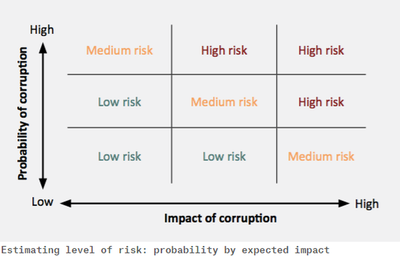Corruption risk management: a smarter option for development aid
The basics of corruption risk management: A framework for decision making and integration into the project cycles introduces U4’s corruption risk management model. The paper provides a pragmatic methodology for corruption prevention in development aid programming. It presents a roadmap for corruption risk management across sectors and disciplines, and discusses how this approach can become a fundamentally new way to think about anti-corruption. The framework can be adapted to build the strongest risk management strategy possible or a lighter, less expensive version, depending on the context — highly corrupt contexts require more resources.
Currently, the measures used to mitigate corruption tend to be rudimentary and ‘one-size-fits-all;’ often chosen in haste and/or without much relevant information. The diagnostic tools available rarely go beyond simply identifying that corruption is a risk.
An effective strategy should be more concerned with identifying the types of corruption most harmful to development in a particular context, assessing the magnitude of their negative impacts, and proposing considered responses to minimise their probability and impact.
Instead of surrendering to corruption risks and abandoning important and urgent development goals, the key is to determine tolerable levels of risk for a specific activity, based on a cost-benefit calculation that balances the risk against the expected benefits. As put in the World Development Report 2014: “the risk of inaction may well be the worst option of all.”

A corruption risk management strategy involves three stages:
- Identification. Pinpointing the types of corruption (bribery, nepotism, etc.) relevant to a process or system.
- Assessment. Estimating the magnitude of each type of risk (probability of occurring multiplied by expected impact).
- Mitigation. Adopting measures to minimise risk, monitoring their effectiveness, and redesigning development interventions as needed.
While fiduciary and reputational risks need to be taken into account, the starting point of the process should be the identification of the risks that corruption poses to development outcomes.
Four aspects of programmes affect corruption risks:
- Budget size and structure
- The capability of partners
- The concrete corruption levels in relevant sectors and institutions
- The service delivery mechanisms
A solid assessment is key: it allows for sound, differentiated choices of cost-effective risk management measures.

An effective risk management strategy begins when investment decisions are made and programmes formulated, and becomes a recurrent activity that continues throughout the project cycle.
The strategy should also contemplate a communication strategy that makes visible the benefits of a corruption risk management framework to audiences both in receiving countries (to build trust) and in donor countries.
The U4 Issue offers an alternative perspective to improve current strategies to address corruption:
A corruption risk management perspective makes clear why aid agencies need to move beyond a concern about fiduciary risk and internal safeguarding of funds to a broader view that considers the impact of corruption on overall development objectives. Corruption is a crime, and immoral, and it should not be tolerated. However, it would, paradoxically, lead to more investments in anti-corruption if corruption were treated as just another risk to development. This perspective would emphasise that curbing corruption is not just the right thing to do, but also the smart thing to do.
Additional resources
J. Johnsøn. 2014. Cost-effectiveness and cost-benefit analysis of governance and anti-corruption activities (U4 Issue 2014:10)
M. Johnston & J. Johnsøn. 2014. Doing the wrong things for the right reasons? “Do no harm” as a principle of reform (U4 Brief 2014:13)
Project
